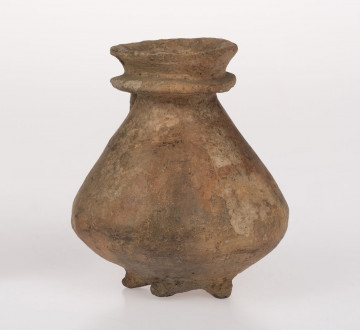
Mug
National Museum in Lublin
Part of the collection: Set of archaeological relics found in the Lublin Region
This inconspicuous figurine, only 4 cm high and less than 8 cm long, is in fact an extremely important archaeological find.
It was discovered at the site of a settlement of the Funnel Beaker culture in the village of Krężnica Jara in the Lublin poviat. The people of this culture (named by archaeologists after their characteristic vessels with elongated and bifurcated necks) inhabited about 5 thousand years ago an enormous area stretching from the present-day Netherlands to Ukraine.
This monument, called a figurine, is in fact a part of an earthenware vessel, which unfortunately has not survived in its entirety to our times. Only a fragment, which was originally the ear of this hand-made vessel, has remained. It depicts a pair of oxen whose necks have been joined together with a yoke - a harness for draught cattle.
Why is this monument so crucial?
Apart from the fact that it is unique on the scale of the Polish lands, it is one of the evidences of the application of new techniques in economy, i.e. ploughing with the use of a wooden ploughshare pulled by oxen, as well as the use of oxen for pulling four-wheeled carts (schematic images of which were discovered by archaeologists on the vessels of this culture).
Thanks to such innovations, the communities of the newly developing agricultural and livestock cultures were able to greatly expand their ability to use the new land for cultivation. A constant source of food facilitated the stabilisation of settlements, which in turn promoted the further development of the community.
Author / creator
Dimensions
cały obiekt: height: 7,8 cm
Object type
dish
Technique
modelling
Material
clay
Creation / finding place
Owner
The National Museum in Lublin
Identification number
Location / status

National Museum in Lublin

National Museum in Lublin

National Museum in Lublin
DISCOVER this TOPIC
Museum of King Jan III's Palace at Wilanów
DISCOVER this PATH
Educational path